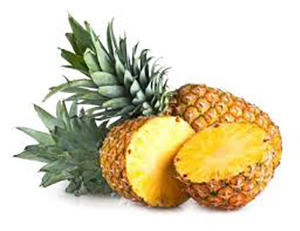The pineapple (Arwas comoxs) is one of the most popular fruits in Guyana. It is available year-round in the domestic market and significant volumes are also exported to Barbados. The principal production areas are in Regions Three and Four. The leading cultivar grown is ‘Montserrat. Lesser quantities of the ‘Sugar Loaf, ‘Smooth Cayenne’, and ‘Tiger Head’ cultivars are also produced.
Fruit of the ‘Montserrat’ cultivar can be subdivided into two distinct biotypes based on fruit size and shape and length of the crown. One biotype has a conical shaped fruit with a shorter crown. The other biotype has a cylindrical fruit shape with a longer crown. Both biotypes have a relatively tough skin small pointed fruitlets (eyes), and a relatively long postharvest life. The internal flesh colour of both biotypes is pale yellow and fruit weight ranges between 1.5 to 3.0 kg.
‘Sugar Loaf pineapples are the sweetest in flavour among tie cultivars produced in Guyana. However, the skin is very delicate and the fruit has a short shelf life. The fruit is oblong and averages about 2 kg in weight. Skin colour is dark green when mature and changes to bright yellow as the fruit ripens. It is highly aromatic when fully ripe.
‘Smooth Cayenne’ fruit is cylindrical with green skin colour and flat broad eyes. The flesh is pale yellow with high acidity, acceptable flavour, and is susceptible to translucency. It is the leading export cultivar produced worldwide and is suitable for both fresh market and processing (canning or juice) – Fruit weight averages around 2 kg. ‘Tiger Head’ is a minimally grown cultivar, mostly produced in the Amerindian settlements in the Hinterland areas. Fruit shape is long and rounded with an average size of 2.5 kg.
Harvesting
Pineapple fruit should be harvested when firm and mature. Pineapples do not improve in eating quality after harvest. Sugar content does not increase after harvest. Therefore, the fruit must be picked at the optimum maturity and ripeness stage to suit the intended market.
Domestically marketed fruits should be harvested close to full ripeness, which in the case of the Montserrat cultivar is at the one-half yellow external surface colour. Fruit is near its maximum mass at this colour stage if still on the plant. Fruit intended for the export market should be picked slightly sooner, at the quarter-yellow colour stage.
It will also be necessary to expeditiously move the product from the field to the parking area to the airport as soon as possible and temperature storage. Fruits picked mature but before full ripeness (i.e. Less than one-quarter yellow) will be firmer and better able to tolerate long-distance transport. However, they will have a less desirable flavour.
Nevertheless, without refrigeration or rapid transport to market, it will be necessary to sacrifice some flavour for adequate firmness to have the potential to export the fruit. Pineapples harvested when immature will not ripen and will have a low sugar content and poor flavour. On the other hand, fruit harvested over mature will get soft and bruise easily during transport and will have a very short market life.



.jpg)








